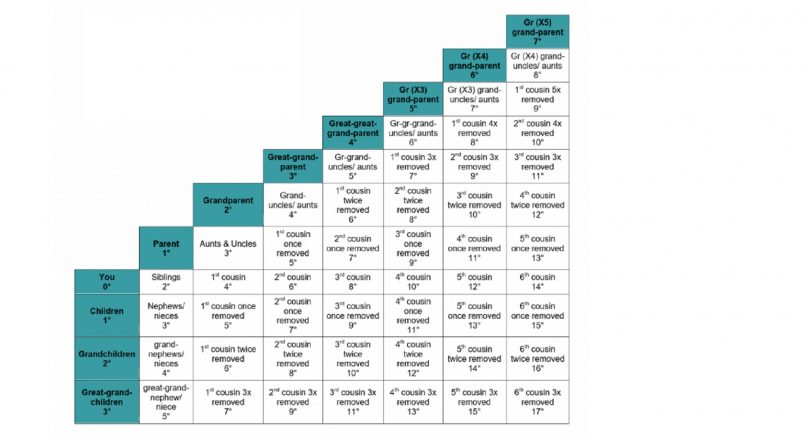Table of Contents
The table of consanguinity is a critical tool for deciding what happens to a person’s estate when they die without a will.
Professional genealogists and attorneys rely on it to establish the degree of consanguinity for every potential heir of estates from the over 60% of Americans that die intestate.
This guide explains the table of consanguinity and how it applies in estate settlement.
Key Takeaways
- If a decedent dies intestate, the probate court applies the respective laws in their place of jurisdiction.
- If there’s no spouse or issue, then probate follows the consanguinity path per the state’s laws of inheritance and distribution.
- Understanding the consanguinity table would help you easily track possible heirs and prepare for a probate case.
What Is Intestacy Succession?

Probate Court Process
Intestate is dying without a valid will. In this case, the probate applies the respective laws in their place of jurisdiction. About nine states, including Texas and Washington, apply the community property inheritance law where half of their estate goes to the partner.
However, most states apply the common law, which places the estate’s ownership to beneficiaries included in a will.
Normally when a person dies intestate, the estate is distributed according to the relationship with the decedent. The pattern starts with spouse, children, grandchildren, and so on.
But what if the decedent didn’t have a family? What if they were an orphan with no spouse or kids? This is where the table of consanguinity comes in handy.
What is Consanguinity?

Understand the table of Consanguinity
The term consanguinity has social and scientific meanings but legally refers to kinship. Typically, genealogists use the table of consanguinity to determine how a person relates to the decedent on a family tree.
The original meaning of consanguinity stipulates people’s relation by blood or descending from a common ancestor, for example, cousins, parents, and siblings.
The best way to depict this extension is through a table where relations do not overlap.
As you can see from the image above, the table of consanguinity starts with you and family links spreading out. Please take note of numbers showing relationship level.
The first degree of consanguinity comprises the children and parents while the second has siblings, grandparents, and grandchildren.
Aunts, uncles, nephews, nieces, and great-grandparents comprise the third degree.
Who To Include in The Table of Consanguinity

You include relatives in the Table of Consanguinity
It’s worth noting that any person related by adoption or second marriage should fall in their position on the table and share the same relationship as if related by blood.
This antique area of law has evolved to adapt to the changing familial and social norms. As a result, half-blood relatives are considered consanguineous descendants of their adoptive parents, and anyone conceived posthumously can also count.
Below are some apparent assumptions in this statutory.
- The estate should benefit the family.
- Closer relatives are prioritized over distant ones.
- Spouses are the priority despite not being related by blood.
- Spouses for other family members don’t rank.
- Children and other issues deserve a portion of the estate.
- Older relatives may be prioritized in some cases.
- Relatives sharing a degree of consanguinity are entitled to equal estate share.
The first five assumptions sit well in probate cases, but the last two may attract opposition given that they allow parents to inherit over a sibling.
An estate benefiting an older relative is rare and mainly deemed unnecessary and impractical, and most families don’t borrow that, especially when many descendants are involved.
How Does Consanguinity Help Determine Heirship?

Consanguinity table is in heir search
If a decedent dies intestate, their spouse or issue becomes the rightful heir. However, if there’s no spouse or issue, then probate follows the consanguinity path under the state’s laws of inheritance and distribution. Usually, the process involves searching for heirs in the lineal descendants, Level 1, 2, and 3 Heirs.
The lineal descendants consist of the spouse, children, grandchildren, and so on. If the decedent has no spouse, then level 1 heirs must be established, and they comprise the decedent’s parents and children.
If no relative from level 1 exists, level 2 heirs must be established, and they comprise grandparents, grandchildren, brothers, and sisters.
The process continues until the furthest level 3, consisting of uncles, aunts, nephews, nieces, great-grandparents, and so on.
See our Heir Research Services, Costs, And Expectations.

family history requires accurate genealogy
Understanding the consanguinity table is one thing and conducting your genealogy is another. In fact, an inaccurate genealogy report would mislead your research no matter how well you understood the table.
Therefore, even as you clam the layout on the table, you need to get your data right. You want accurate names, locations, and dates of that niece who appears as the closest relative and potential heir in intestate succession.
Luckily, experts at Record Click can help navigate the intricacies of family history research. Besides perfecting genealogy research, they clearly understand what is required by law.
Simply put, our forensic genealogists help clients fulfill their fiduciary duty with detailed and factual information.
When conducting the level 1 search, we consider the stirpes or per capita basis. Similarly, the level 2 heir search involves two concurrent searches for the maternal and paternal grandparents. It’s worth noting that most complicated cases we’ve handled end at level 2 search, but if need be, we have the expertise to establish heirs no matter how far it takes us.
Prove Your Familial Blood Link
If you’re a fiduciary professional seeking answers on heirship and data presentation in court, Record Click can help. We also offer free consultation if you need more time to start searching.
Estate planning is inherently personal, and the legislative solutions may not conform to your circumstances. Therefore, the best advice is to plan now, and we can help with that, too.







